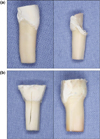1. Takuma S. Preliminary report on the mineralization of human dentin. J Dent Res. 1960. 39:964–972.

2. Doyon GE, Dumsha T, von Fraunhofer JA. Fracture resistance of human root dentin exposed to intracanal calcium hydroxide. J Endod. 2005. 31(12):895–897.

3. Cvek M. Prognosis of luxated non-vital maxillary incisors treated with calcium hydroxide and filled with gutta-percha. A retrospective clinical study. Endod Dent Traumatol. 1992. 8(2):45–55.

4. Goncalves LA, Vansan LP, Paulino SM, Sousa Neto MD. Fracture resistance of weakened roots restored with a transilluminating post and adhesive restorative materials. J Prosthet Dent. 2006. 96(5):339–344.

5. Carvalho CA, Valera MC, Oliveira LD, Camargo CH. Structural resistance in immature teeth using root reinforcements
in vitro. Dent Traumatol. 2005. 21(3):155–159.

6. Bortoluzzi EA, Souza EM, Reis JM, Esberard RM, Tanomaru-Filho M. Fracture strength of bovine incisors after intra-radicular treatment with MTA in an experimental immature tooth model. Int Endod J. 2007. 40(9):684–691.

7. Bramante CM, Menezes R, Moraes IG, Bernardinelli N, Garcia RB, Letra A. Use of MTA and intracanal post reinforcement in a horizontally fractured tooth: a case report. Dent Traumatol. 2006. 22(5):275–278.

8. Tay FR, Pashley DH. Monoblocks in root canals: a hypothetical or a tangible goal. J Endod. 2007. 33(4):391–398.

9. Radovic I, Corciolani G, Magni E, Krstanovic G, Pavlovic V, Vulicevic ZR, et al. Light transmission through fiber post: The effect on adhesion, elastic modulus and hardness of dual-cure resin cement. Dent Mater. 2009. 25(7):837–844.

10. D'Arcangelo C, Cinelli M, De Angelis F, D'Amario M. The effect of resin cement film thickness on the pullout strength of a fiber-reinforced post system. J Prosthet Dent. 2007. 98(3):193–198.
11. Yoldas O, Akova T, Uysal H. An experimental analysis of stresses in simulated flared root canals subjected to various post-core applications. J Oral Rehabil. 2005. 32(6):427–432.

12. Kim JW, Yu MK, Lee SJ, Lee KW. Microtensile Bonding of Resin Fiber Reinforced Post to Radicular Dentin Using Resin Cement. J Korean Acad Conserv Dent. 2003. 28(1):80–88.

13. Schmage P, Sohn J, Ozcan M, Nergiz I. Effect of surface treatment of titanium posts on the tensile bond strength. Dent Mater. 2006. 22(2):189–194.

14. Krejci I, Lutz F. [In-vitro test results of the evaluation of dental restoration systems. Correlation with in-vivo results]. Schweiz Monatsschr Zahnmed. 1990. 100(12):1445–1449.
15. Soares CJ, Pizi EC, Fonseca RB, Martins LR. Influence of root embedment material and periodontal ligament simulation on fracture resistance tests. Braz Oral Res. 2005. 19(1):11–16.

16. Moosavi H, Maleknejad F, Kimyai S. Fracture resistance of endodontically-treated teeth restored using three root-reinforcement methods. J Contemp Dent Pract. 2008. 9(1):30–37.

17. Naumann M, Preuss A, Frankenberger R. Reinforcement effect of adhesively luted fiber reinforced composite versus titanium posts. Dent Mater. 2007. 23(2):138–144.

18. Brown WS, Jacobs HR, Thompson RE. Thermal fatigue in teeth. J Dent Res. 1972. 51(2):461–467.

19. Sano H, Ciucchi B, Matthews WG, Pashley DH. Tensile properties of mineralized and demineralized human and bovine dentin. J Dent Res. 1994. 73(6):1205–1211.

20. Valois CR, Costa ED Jr. Influence of the thickness of mineral trioxide aggregate on sealing ability of root-end fillings
in vitro. Oral Surg Oral Med Oral Pathol Oral Radiol Endod. 2004. 97(1):108–111.

21. Hachmeister DR, Schindler WG, Walker WA 3rd, Thomas DD. The sealing ability and retention characteristics of mineral trioxide aggregate in a model of apexification. J Endod. 2002. 28(5):386–390.

22. Coneglian PZ, Orosco FA, Bramante CM, Moraes IG, Garcia RB, Bernardineli N.
In vitro sealing ability of white and gray mineral trioxide aggregate (MTA) and white Portland cement used as apical plugs. J Appl Oral Sci. 2007. 15(3):181–185.

23. Seo MS, Shon WJ, Lee WC, Yoo HM, Cho BH, Baek SH. Finite Element Analysis of Maxillary Central Incisors Restored with Various Post-and-Core Applications. J Korean Acad Conserv Dent. 2009. 34(4):324–332.

24. Lim DY, Kim HC, Hur B, Kim KH, Son K, Park JK. Stress Distribution of Endodontically Treated Maxillary Second Premolars Restored with Different Methods: Three-Dimensional Finite Element Analysis. J Korean Acad Conserv Dent. 2009. 34(1):69–80.

25. Beck P, Ghuman T, Cakir D, Ramp L, Burgess J. Evaluation of Flexural Strength and Elastic Modulus of Endodontic Posts. 2009.
26. Al-Omiri MK, Al-Wahadni AM. An ex vivo study of the effects of retained coronal dentine on the strength of teeth restored with composite core and different post and core systems. Int Endod J. 2006. 39(11):890–899.

27. Abdul Salam SN, Banerjee A, Mannocci F, Pilecki P, Watson TF. Cyclic loading of endodontically treated teeth restored with glass fibre and titanium alloy posts: fracture resistance and failure modes. Eur J Prosthodont Restor Dent. 2006. 14(3):98–104.
28. Mitsui FH, Marchi GM, Pimenta LA, Ferraresi PM. In vitro study of fracture resistance of bovine roots using different intraradicular post systems. Quintessence Int. 2004. 35(8):612–616.
29. Akkayan B, Gulmez T. Resistance to fracture of endodontically treated teeth restored with different post systems. J Prosthet Dent. 2002. 87(4):431–437.

30. Lassila LV, Tanner J, Le Bell AM, Narva K, Vallittu PK. Flexural properties of fiber reinforced root canal posts. Dent Mater. 2004. 20(1):29–36.

31. Mannocci F, Sherriff M, Watson TF, Vallittu PK. Penetration of bonding resins into fibre-reinforced composite posts: a confocal microscopic study. Int Endod J. 2005. 38(1):46–51.

32. Abo El-Ela OA, Atta OA, El-Mowafy O. Microtensile Bond Strength of Nonmetallic Dowels Bonded to Radicular Dentin with Self-Etch Adhesives. J Prosthodont. 2008. 18(2):167–171.

33. Hagge MS, Wong RD, Lindemuth JS. Effect of dowel space preparation and composite cement thickness on retention of a prefabricated dowel. J Prosthodont. 2002. 11(1):19–24.

34. Pereira JR, de Ornelas F, Conti PC, do Valle AL. Effect of a crown ferrule on the fracture resistance of endodontically treated teeth restored with prefabricated posts. J Prosthet Dent. 2006. 95(1):50–54.

35. Isidor F, Brondum K, Ravnholt G. The influence of post length and crown ferrule length on the resistance to cyclic loading of bovine teeth with prefabricated titanium posts. Int J Prosthodont. 1999. 12(1):78–82.




 PDF
PDF ePub
ePub Citation
Citation Print
Print












 XML Download
XML Download